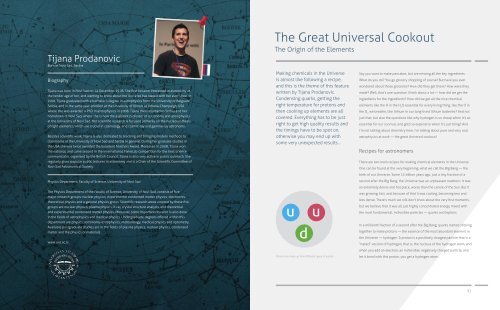Sol Lucet Omnibus - ESO
Sol Lucet Omnibus - ESO
Sol Lucet Omnibus - ESO
- TAGS
- lucet
- omnibus
- www.eso.org
You also want an ePaper? Increase the reach of your titles
YUMPU automatically turns print PDFs into web optimized ePapers that Google loves.
Tijana Prodanovic<br />
Born in Novi Sad, Serbia<br />
Biography<br />
Tijana was born in Novi Sad on 14 December 1978. She first became interested in astronomy at<br />
the tender age of ten, and wanting to know about the Universe has stayed with her ever since. In<br />
2001 Tijana graduated with a bachelor’s degree in astrophysics from the University of Belgrade,<br />
Serbia, and in the same year enrolled at the University of Illinois at Urbana-Champaign, USA<br />
where she was awarded a PhD in astrophysics in 2006. Tijana then returned to Serbia and her<br />
hometown of Novi Sad, where she is now the assistant professor of astronomy and astrophysics<br />
at the University of Novi Sad. Her scientific research is focused primarily on the nucleosynthesis<br />
of light elements, which are crucial in cosmology, and cosmic-ray and gamma-ray astronomy.<br />
Besides scientific work, Tijana is also dedicated to teaching and bringing modern methods to<br />
classrooms at the University of Novi Sad and Serbia in general. During her graduate studies in<br />
the USA she was twice awarded the Excellent Teachers Award. Moreover, in 2008, Tijana won<br />
the national, and came second in the international, FameLab competition for the best science<br />
communicator, organised by the British Council. Tijana is also very active in public outreach. She<br />
regularly gives popular public lectures in astronomy and is a Chair of the Scientific Committee of<br />
Novi Sad Astronomical Society.<br />
Physics Department, Faculty of Science, University of Novi Sad<br />
The Physics Department of the Faculty of Science, University of Novi Sad, consists of five<br />
major research groups: nuclear physics, experimental condensed matter physics, electronics,<br />
theoretical physics and a general physics group. Scientific research areas covered by these five<br />
groups are nuclear physics, plasma physics, X-ray crystal structure analysis, and theoretical<br />
and experimental condensed matter physics. Moreover, some important research is also done<br />
in the fields of astrophysics and medical physics. Undergraduate degrees offered within this<br />
department are physics, astronomy-astrophysics, meteorology, medical physics and optometry.<br />
Available postgraduate studies are in the fields of plasma physics, nuclear physics, condensed<br />
matter and the physics of materials.<br />
www.uns.ac.rs<br />
The Great Universal Cookout<br />
The Origin of the Elements<br />
Making chemicals in the Universe<br />
is almost like following a recipe,<br />
and this is the theme of this feature<br />
written by Tijana Prodanovic.<br />
Condensing quarks, getting the<br />
right temperature for protons and<br />
then cooking up elements are all<br />
covered. Everything has to be just<br />
right to get high quality results and<br />
the timings have to be spot on,<br />
otherwise you may end up with<br />
some very unexpected results...<br />
u<br />
d<br />
u<br />
Protons are made up from different types of quarks.<br />
Say you want to make pancakes, but are missing all the key ingredients.<br />
What do you do? You go grocery shopping of course! But have you ever<br />
wondered about those groceries? How did they get there? How were they<br />
made? Well, that’s one question I think about a lot — how did we get the<br />
ingredients for the ingredients? How did we get all the nice chemical<br />
elements like the H in the H O essential for every living thing, like the O in<br />
2<br />
the O we breathe, like lithium in our long-lived lithium batteries? And not<br />
2<br />
just that, but also the questions like why hydrogen is so cheap when it’s so<br />
essential for our survival, and gold so expensive when it’s just bling? And<br />
I’m not talking about chemistry here. I’m talking about pure and very cool<br />
astrophysics at work — the great Universal cookout!<br />
Recipes for astronomers<br />
There are two main recipes for making chemical elements in the Universe.<br />
One can be found at the very beginning, what we call the Big Bang — the<br />
birth of our Universe. Some 13 billion years ago, just a tiny fraction of a<br />
second after the Big Bang, the Universe was an unpleasant newborn. It was<br />
an extremely dense and hot place, worse than the centre of the Sun. But it<br />
was growing, fast, and because of that it was cooling, becoming less and<br />
less dense. There’s much we still don’t know about the very first moments,<br />
but we believe that it was all just highly concentrated energy mixed with<br />
the most fundamental, indivisible particles — quarks and leptons.<br />
In a millionth fraction of a second after the Big Bang, quarks started sticking<br />
together to make protons — the essence of the most abundant element in<br />
the Universe — hydrogen. A proton is a positively charged particle that is a<br />
“naked” version of hydrogen, that is, the nucleus of the hydrogen atom, and<br />
when you add an electron, an indivisible, negatively charged particle, and<br />
let it bond with this proton, you get a hydrogen atom.<br />
93

















